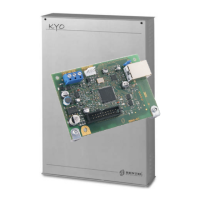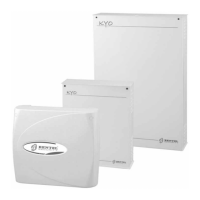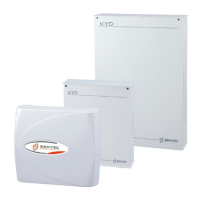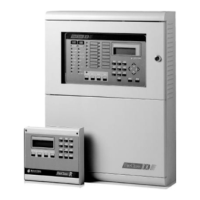Do you have a question about the Bentel Security KYO and is the answer not in the manual?
Overview of the main control panel and its features.
How your installer configures your system for your specific needs.
Ways to interact with and control the security system.
Explains the integrated digital communicator function.
Details on using Vector/RX receivers for wireless devices.
Describes different keypad models and their operations.
Explains the meaning of various LED indicators on keypads.
How to access and interpret trouble conditions on the keypad.
Steps to view the armed or disarmed status of system partitions.
Details on the LCD display and standby status information.
Guide to adjusting volume, contrast, and brightness.
Procedures for viewing and understanding specific trouble details.
How the buzzer signals events and what superkeys do.
Explains fundamental operations like arming and disarming.
Covers Global, A, and B mode arming, including quick arm.
Notes on arming conditions and silencing alarms from keypads.
Instructions for accessing and using the main user menu.
Procedures to clear alarm memory and reset system states.
How to arm and disarm partitions using the user menu.
Making requests for overtime or teleservice assistance.
Enabling or disabling automatic arming features.
Configuring the teleservice feature for remote maintenance.
Configuring keypad buzzer behavior for alerts.
Managing the answer function and controlling system outputs.
How to change or delete programmed telephone numbers.
Guide to programming and changing access codes for users.
Procedures for setting system date/time and testing the siren.
How to check zone status and bypass/unbypass zones.
How to review system events and alarms from the event logger.
Interrupting and clearing ongoing alarm calls.
Introduces readers and the types of keys/cards supported.
Details on SAT keys and PROXI cards for system access.
Explains the meaning of LED indicators on readers.
Basic operations like disarming and stopping alarms with keys/cards.
How to arm the system in Global, A, or B modes using keys/cards.
Procedures for silencing alarms and inhibiting system functions.
Explains Dialler and Answer modes for remote control.
How to authenticate when accessing the system by phone.
Details on canceling, stopping alarms, talk/listen functions.
Controlling arming, disarming, and managing telephone access codes remotely.
Overview of wireless key functionality and assignment.
How to perform global arming and disarming with a wireless key.
Using the wireless key to arm the system in A or B modes.
Overview of the main control panel and its features.
How your installer configures your system for your specific needs.
Ways to interact with and control the security system.
Explains the integrated digital communicator function.
Details on using Vector/RX receivers for wireless devices.
Describes different keypad models and their operations.
Explains the meaning of various LED indicators on keypads.
How to access and interpret trouble conditions on the keypad.
Steps to view the armed or disarmed status of system partitions.
Details on the LCD display and standby status information.
Guide to adjusting volume, contrast, and brightness.
Procedures for viewing and understanding specific trouble details.
How the buzzer signals events and what superkeys do.
Explains fundamental operations like arming and disarming.
Covers Global, A, and B mode arming, including quick arm.
Notes on arming conditions and silencing alarms from keypads.
Instructions for accessing and using the main user menu.
Procedures to clear alarm memory and reset system states.
How to arm and disarm partitions using the user menu.
Making requests for overtime or teleservice assistance.
Enabling or disabling automatic arming features.
Configuring the teleservice feature for remote maintenance.
Configuring keypad buzzer behavior for alerts.
Managing the answer function and controlling system outputs.
How to change or delete programmed telephone numbers.
Guide to programming and changing access codes for users.
Procedures for setting system date/time and testing the siren.
How to check zone status and bypass/unbypass zones.
How to review system events and alarms from the event logger.
Interrupting and clearing ongoing alarm calls.
Introduces readers and the types of keys/cards supported.
Details on SAT keys and PROXI cards for system access.
Explains the meaning of LED indicators on readers.
Basic operations like disarming and stopping alarms with keys/cards.
How to arm the system in Global, A, or B modes using keys/cards.
Procedures for silencing alarms and inhibiting system functions.
Explains Dialler and Answer modes for remote control.
How to authenticate when accessing the system by phone.
Details on canceling, stopping alarms, talk/listen functions.
Controlling arming, disarming, and managing telephone access codes remotely.
Overview of wireless key functionality and assignment.
How to perform global arming and disarming with a wireless key.
Using the wireless key to arm the system in A or B modes.
| Model | KYO |
|---|---|
| Dimensions | 320 x 440 x 100 mm |
| Communication | GSM, PSTN |
| Backup Battery | 12V 7Ah |
| Operating Temperature | -10°C to +50°C |
| Compatibility | Bentel Security peripherals |











